
What Temperature Do You Wash Bedding At? (for every fabric type)
When it comes to keeping your bedding fresh and free from germs, choosing the right wash temperature is crucial.
If you’re wondering what temperature to wash your bedding at, the answer isn’t one-size-fits-all. But one thing’s for sure: hot washes (around 60°C) can be your best bet for getting rid of bacteria and allergens.
In this article, you’ll discover the best temperatures for washing your bedding, and when hot, warm, or cold washes might be the right choice!
Choosing The Right Temperature For Washing Your Bedding
Washing bedding isn’t just about getting rid of dirt and stains. It’s also about keeping your bedding clean and free from the presence of pesky allergens and germs that accumulate over time.
For most bedding, the ideal temperature for washing is around 60°C. This higher heat setting is effective at killing bacteria, dust mites, and allergens lurking in your sheets, pillowcases, duvet covers, and more.
However, not all bedding can handle the same amount of heat. Delicate materials like silk and satin may not do well in scalding water. So, the temperature you use depends on the type of bedding you own.
| Wash Temperature | Suitable for Fabric Types | Benefits | Considerations |
|---|---|---|---|
| Hot (around 60°C or higher) | Cotton and durable fabrics | Effective in killing bacteria, dust mites, and allergens | Can shrink or damage delicate fabrics; always read care labels |
| Warm (between 40°C and 50°C) | Cotton, polyester, linen, synthetic blends | Balances cleaning power and fabric care, reducing allergens and bacteria without harsh effects | Ideal for medium-soiled bedding; check fabric compatibility |
| Cold (around 30°C or lower) | Silk, satin, wool, high-quality microfibre | Prevents damage to temperature-sensitive fabrics; energy saving | May not remove heavy soil or stains effectively without pre-treatment |
Hot Washes – Are They Okay For Your Bedding?
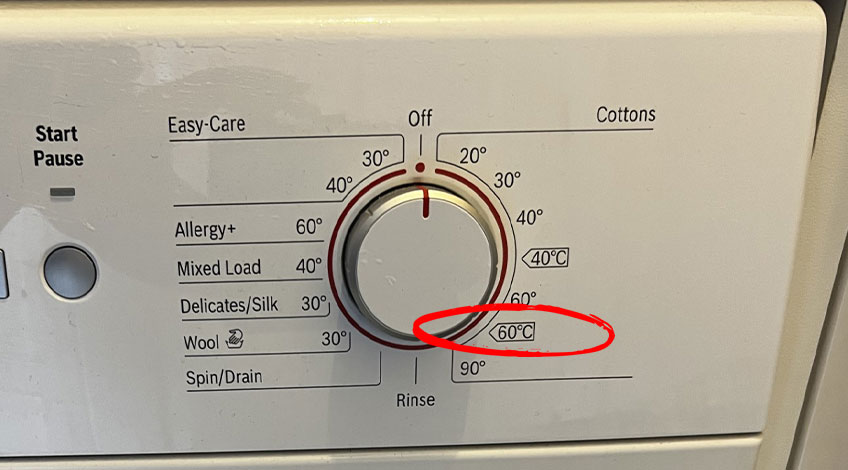
Your bedding items, from bed sheets to duvet covers, accumulate sweat, oil, dust, and hair day after day. To eliminate these culprits effectively, hot washes at around 60°C or higher are your best choice. Cotton bedding, in particular, benefits from this high-temperature treatment.
NOTE: It’s important to always read the care label before tossing your bedding in the washer. The care label provides essential instructions on how to launder the fabric properly, helping you avoid unintentional damage!
Warm Washes – Are They Okay For Your Bedding?
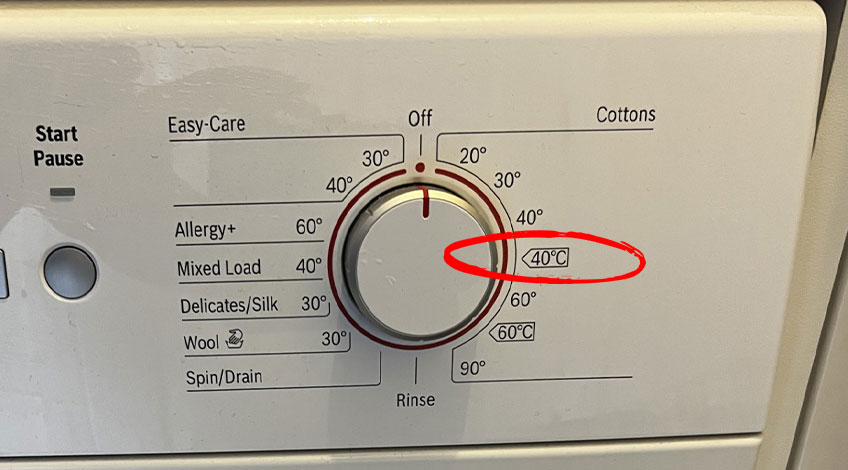
If you want to give your bedding a good clean without the risk of shrinking it, a warm wash with a temperature between 40°C and 50°C is the sweet spot.
This temperature range works well for different fabrics, such as cotton, polyester, linen, and synthetic blends. It offers an ideal balance, cleaning medium-soiled bedding thoroughly without fabric damage.
Additionally, it tackles stains and reduces allergens and bacteria, without the harsh effects of high temperatures.
Cold Washes – Are They Okay For Your Bedding?
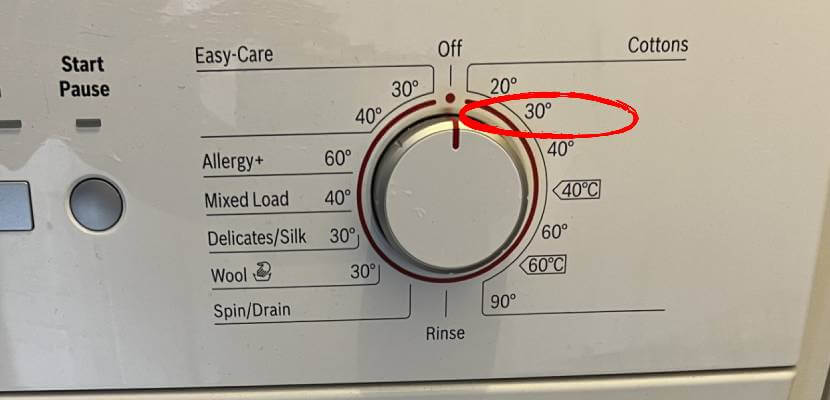
For delicate bedding such as silk, satin, wool, and high-quality micro-fibre, cold washes with temperatures around 30°C or lower are the way to go. These temperature-sensitive fabrics require gentle care to prevent damage.
Keep in mind that cold washes may not reach deep enough to cleanse the fibres in heavily soiled bedding. In such cases, pre-treating stains with a stain remover is essential before washing, especially for heavier bedding like duvets and covers.
- Removes tough stains at 20°C in 30 minutes in just one wash
- Helps prevent colour transfer in your wash, keeping your colours vibrant & safe
TIP: When washing delicate items, it will help to use mild detergent, as some fabrics may react negatively to harsh chemicals.
SEE ALSO: How To Kill Bacteria In A 30 Degree Wash (using antibacterial laundry sanitiser)
Best Tips For Washing Your Bedding
Now that you know the right wash temperatures for your bedding, let’s explore some additional tips to ensure your bedding remains fresh and lasts a long time.
Always, Always, Read Care Labels
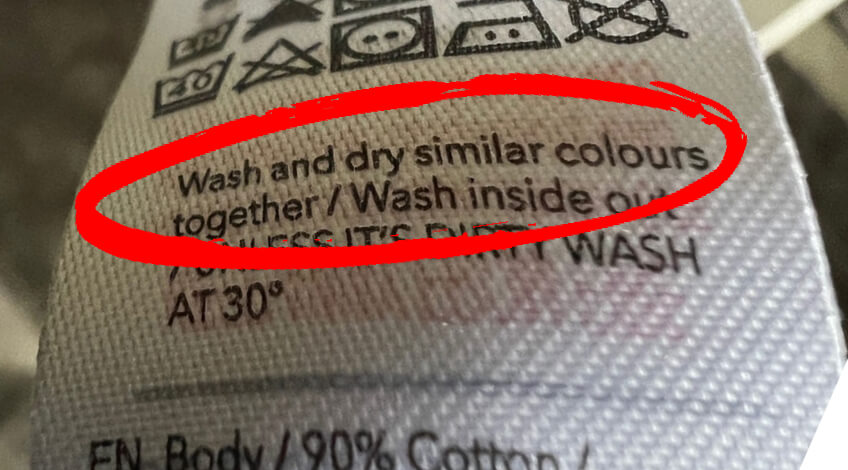
As mentioned earlier, your bedding’s care labels hold important information.
They provide specific washing instructions, recommended water temperatures, wash settings, and other essential tips to keep your bedding in great condition. It’s easy to overlook, but always check these tags to see what temperature to wash bed sheets or pillowcases at, especially for new purchases.
Sort By Fabric And Colour
To prevent colour transfer and fabric damage, separate your bedding items by category!
Group them by fabric to prevent snagging, and sort by similar colours to reduce the possibility of dye transfer. This simple step can extend the life of your bedding!
SEE ALSO: What Temperature Do Colours Run At? (the full guide)
Avoid Overloading Your Washing Machine
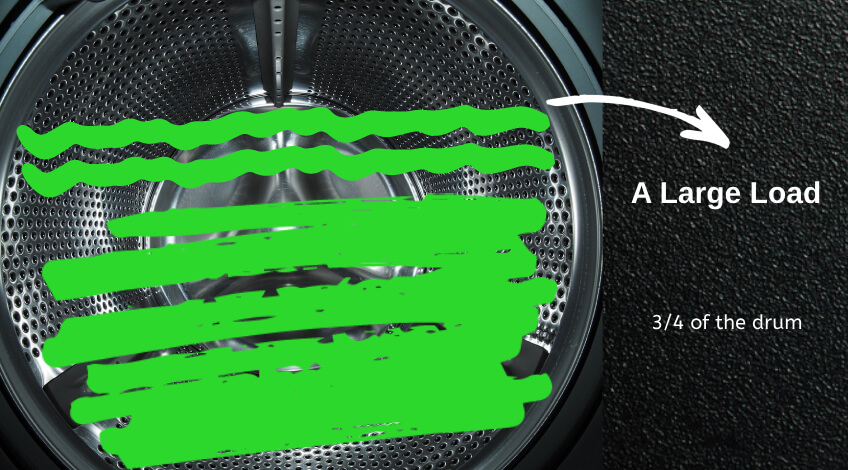
Don’t stuff your washing machine to the brim. It’s recommended to fill it only about half to three-quarters full for efficient cleaning. Overloading can lead to incomplete washing, more wrinkles, and fabric damage.
SEE ALSO: How Much Should You Fill A Washing Machine? (easy guide)
Dry Your Bedding Appropriately
Did you know that it’s best to fill your tumble dryer to only 1/2 to 3/4 capacity?
Overloading can lead to less effective cleaning, more wrinkles, and potential fabric damage. A properly loaded machine ensures your bedding gets the thorough drying it needs.
Sanitising Without Heat
If high-temperature washing isn’t ideal for your bedding, consider using sanitising detergents and sun-drying as effective alternatives.
Sanitising detergents, designed for low temperatures, kill bacteria without harming delicate fabrics. Choose eco-friendly options to keep bedding fresh and allergen-free.
Additionally, sun-drying your bedding can naturally eliminate bacteria and dust mites, thanks to UV rays. This method not only conserves energy but also extends the life of your bedding by avoiding the wear from tumble drying.
Rotate Your Bedding
If you have more than one set of bedding, rotating them can extend their lifespan!
Giving your bedding a break between use and washing ensures it stays fresh and comfortable for longer.
Have A Regular Washing Schedule

Lastly, the key to ensuring your bedding is consistently clean and fresh is by establishing a regular laundry schedule.
This not only ensures thorough cleaning but also saves you time in the long run.
How Often Do You Need To Wash Your Bedding?
Now that you understand the best temperature settings and the ins and outs of caring for your bedding, let’s address how often you should launder your various bedding items.
- Sheets, pillowcases, and light blankets
These should be washed every one to two weeks to keep them fresh and free from allergens. - Duvet covers
Wash them every two weeks to a month, or even longer if you use a top sheet. - Heavy blankets, duvets, pillows, and comforters
These items should be washed every couple of months, typically around the 3 to 6-month mark.
NOTE: If you have allergies, you’ll need to change out and wash your bedding more often to remove allergens and maintain a healthy sleep environment.
Sleep Easy When Your Bed Is Comfy
Your bed should be a sanctuary of comfort, not a breeding ground for dust mites and bacteria.
By understanding the right temperature for washing your bedding and following these tips, you can enjoy a cleaner, cosier, and more allergen-free sleep space. So, read those care labels, sort your bedding wisely, and give your bedding the care it deserves for many peaceful nights ahead!
SEE ALSO: Can You Fit A King Size Duvet In A 7, 8, 9 or 10 KG Washing Machine?
Frequently Asked Questions
The best setting for washing bedding depends on the type of fabric. For most bedding, a hot wash at around 60°C is effective, but delicate materials like silk may require a cold wash.
Bacteria can be effectively killed in the washing machine with a hot wash at around 60°C or higher.
To wash silk sheets, use a cold wash with temperatures around 30°C or lower. Always follow the care label’s instructions and use a mild detergent to avoid damage.
It’s advisable to wash new sheets before using them. This helps remove any residual chemicals, dust, or germs from the manufacturing and packaging process, ensuring a fresh and clean sleep surface.
If you don’t wash your bedding regularly, it can accumulate sweat, oils, dust, and allergens, leading to an unhygienic sleep environment. Additionally, neglecting to wash bedding at the recommended temperature can result in discomfort, allergies, and reduced lifespan.





